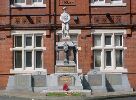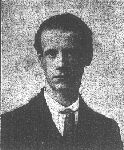
Newton-le-Willows and
Earlestown War Memorial

| OTHER WARS |
 |
Newton-le-Willows andEarlestown War Memorial |
 |
| The
Great War Roll of Honour |
|||||||||||||||||||||||||

Lance-Corporal Walter Ball was born in Kidderminster, the son
of Walter and Martha Ball. At the time of his death he lived at 14, Alfred Street,
Mill Lane in Newton-le-Willows. He joined up on 31st August, 1914, less than
a month after the outbreak of the War. Previously he had worked at Messrs. Caulfield's
Bleachworks. He was connected with St.
Peter's Church, where he was a Sergeant in the Church Lads Brigade. According
to the "Newton and Earlestown Guardian" issue of 9th April 1915, his
mother received a letter from Private William Rimmer telling her that Walter
had been fatally shot on 1st April at about 1.00 am.
He was buried in Dickebusch New Military
Cemetery, in the village of Dikkebus (the modern Flemish spelling), south-west
of Ieper. This cemetery was begun in February 1915, and was used until May 1917
by fighting units and field ambulances. It contains 624 First World War burials.
Lance Corporal Ball was one of the first casualties from Newton-le-Willows,
so was commemorated in a poem published
in the local newspaper, the “Earlestown and Newton Guardian”. The
“Warrington Guardian” published a photograph of a group of Newton
soldiers which included Walter Ball.
Captain H. Whalley-Kelly, in his book "Ich Dien", describes this period
of the 1st/4th Battalion's history:
“On 25th March the unit moved from Westoutre to Dickebusch and on the
next day, to the trenches opposite the village of St. Eloi, where the field
drains were so near the surface it was impossible to dig deeply, and breastworks
were necessary as a protection against the enemy's fire. This was an area where
severe fighting had taken place in 1914 and dead soldiers of both sides, half
exposed, lay where they had fallen several months before, while in the ruined
farms the bodies of civilians of both sexes and all ages, unshriven and unburied,
served as a reminder of the ruthlessness of modern war.
“This tour in the front line lasted until 1st April, when the 1st/4th
was relieved by the 2nd Battalion and returned to billets on the Dickebusch-La
Clytte road, having acquitted itself well in this, its first independent spell
of duty as the garrison of an important sector of the British front. The remainder
of the month was spent in ordinary trench routine, the 2nd and 4th Battalions
relieving each other at regular intervals and each providing working parties,
while out of line, for pioneer work* in the forward areas; a dangerous and uncomfortable
form of "amusement" as all who took part will well remember."
* "pioneer work" mainly involved digging trenches. On 15th October
1915, the 1st/4th became the Pioneer Battalion with the
3rd Division, then on 9th January 1916 with the
55th Division, where they remained for the rest of the War.